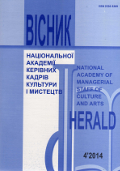ПСИХОФІЗІОЛОГІЧНІ ОСОБЛИВОСТІ ВИКОНАННЯ ТВОРІВ ДЛЯ ІНСТРУМЕНТА СОЛО (на прикладі духового музично-виконавського мистецтва)
The psychophysiological peculiarities of the performance of the compositions for instrument’s solo (for example of wind musical performing arts).
Author(s): Valeriy HromchenkoSubject(s): Psychology, Music
Published by: Національна академія керівних кадрів культури і мистецтв
Keywords: psychophysiology; performer; composer; compositions; instrument; means of expression; genre; conditioned reflex; muscle; consciousness; process;
Summary/Abstract: Researchers are studying the processes of psychophysiology during performance of compositions for instrument’s solo. The research is conducted on the example a wind musical performing arts. It is established that psychophysiology of the compositions solo formed on character logical genre-based music of this kind. Their primary criterion is the individual nature of playing and using a palette of expressive possibilities only one instrument.The psychophysiology of these works discloses at an early, middle and final period of the musician’s work. The independence and autonomy of the artistic image is generally in the compositions for instrument’s solo. An instrumentalist always plays only one on stage in this genre. A musician draws only one musical picture on his instrument and in his consciousness.The instrumentalist must overcome the psychological barer when he goes only one on a concert stage. The way of overcoming it lies in understanding the nature of the genre of music for instrument’s solo. The musician should see an artistic image and understand it as the most important in the composition.The conditioned reflex is the basis of performing. There are very manyconditioned reflexes during the play on the wind instrument. They create a lot of expressive techniques. There are traditional methods as well as nontraditional techniques. The traditional methods and systems are used in very many genres of modern music art. They are the polyphony, the microtonal music, noise effects, tonal paint and many others. The modern performers on wind instruments play these techniques very well.The contemporary instrumentalists are also composers. Precisely in the compositions for instrument’s solo the musicians see themselves as composers. They create the composers that they performing this music and even use it in the learning process. Among the internationally renowned and constantly performed solo compositions we can name the cycle of plays "Dedication" for clarinet solo of the Hungarian clarinetist, composer and teacher B. Kovacs, the fantasy for various wooden and brass instruments solo of the British composer, trumpeter and conductor M. Arnold , the caprices for solo clarinet of the Russian clarinetist, teacher and composer Ivan Olenchyk, the improvisation for trombone solo of the Uruguay-German trombonist, composer and arranger E. Crespo and the others.Modern composers are expanding the artistic palette of musicians. They also are creating a new physiological characteristics performance of a lot of compositions for solo instrument. The contemporary researchers must pay attention to the performers on string instruments. The scientists should to conduct a theoretical analysis of the solo compositions in various shapes. The special studies and experiments should be carried out by many instrumentalists.
Journal: Вісник Національної академії керівних кадрів культури і мистецтв
- Issue Year: 2014
- Issue No: 4
- Page Range: 79-84
- Page Count: 6
- Language: Ukrainian

